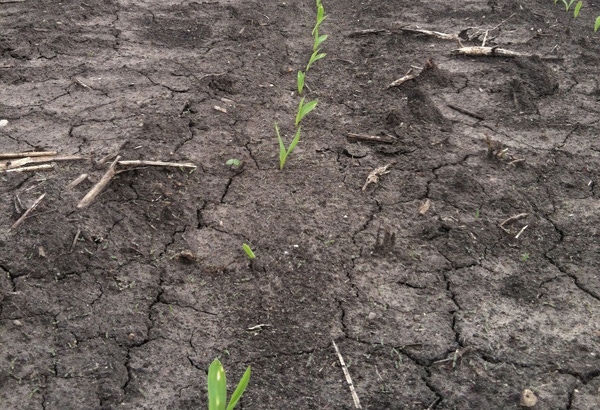May 21, 2013

According to the USDA/NASS for the week ending May 19, corn was 74% planted. In some areas, farmers were able to start and finish their corn planting within the week. Corn emergence has generally been rapid and many fields planted in early May are now easily rowed from the road.
Troubleshooting emergence problems early is critical in identifying solutions and developing successful replant plans, if needed. Here's a list of a few common things to look for if you encounter an emergence problem in corn this spring.
No seed present. May be due to planter malfunction or bird or rodent damage. The latter often will leave some evidence such as digging or seed or plant parts on the ground.
Shoot unfurled, leafing-out underground. Could be due to premature exposure to light in cloddy soil, planting too deep, compaction or soil crusting, extended exposure to acetanilide herbicides under cool wet conditions, combinations of several of these factors, or may be due to extended cool wet conditions alone.
Seed with poorly developed root or shoot (coleoptile), coleoptile tip brown or yellow. Could be seed rots or seed with low vigor. Although corn has just started to emerge, or has not yet emerged in many fields, growers should carefully inspect seedlings for symptoms of disease, especially in lower lying areas of fields where ponding and saturated soils were more likely.
Seeds and seedlings that are brown in color, are soft, and fall apart easily while digging, are obviously dead or dying. Seeds and seedling roots or shoots with white to pinkish mold growing on them are likely victims of fungal attack and will likely die. Pythium and Fusarium are common fungi that attack plants and cause these damping-off or seedling blight symptoms under wet, cool conditions. It is more difficult to diagnose disease damage on plants that also show abnormal growth caused by cold soil conditions or by crusting of the soil surface. However, dark, discolored roots and crowns, instead of a healthy creamish-white appearance, are typical symptoms of seedling diseases problems. So, it is best to check these seedlings very closely for dark brown or soft areas on seedling roots and shoots. Any discoloration will indicate a problem that could worsen if the soils remain cold or wet.
Read more emergence problems from Ohio State.
You might also like:
You May Also Like




